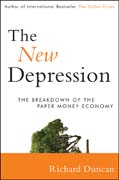
Why the global recession is in danger of becoming another Great Depression, and how we can stop itWhen the United States stopped backing dollars with gold in 1968, the nature of money changed. All previous constraints on money and credit creation were removed and a new economic paradigm took shape. Economic growth ceased to be driven by capital accumulation and investment as it had beensince before the Industrial Revolution. Instead, credit creation and consumption began to drive the economic dynamic. In The New Depression: The Breakdown of the Paper Money Economy, Richard Duncan introduces an analytical framework,The Quantity Theory of Credit, that explains all aspects of the calamity now unfolding: its causes, the rationale for the government's policy response to the crisis, what is likely to happen next, and how those developments will affect asset prices and investment portfolios.In his previous book, The Dollar Crisis (2003), Duncan explained why a severe global economic crisis was inevitable given the flaws in the post-Bretton Woods international monetary system, andnow he's back to explain what's next. The economic system that emerged following the abandonment of sound money requires credit growth to survive. Yet the private sector can bear no additional debt and the government's creditworthiness is deteriorating rapidly. Should total credit begin to contract significantly, this New Depression will become a New Great Depression, with disastrous economic and geopolitical consequences. That outcome is not inevitable, and thisbook describes what must be done to prevent it.Presents a fascinating look inside the financial crisis and how the New Depression is poised to become a NewGreat DepressionIntroduces a new theoretical construct, The Quantity Theory of Credit, that is the key to understanding not only the developments that led to the crisis, but also to understanding how events will play out in the yearsaheadOffers unique insights from the man who predicted the global economic breakdownAlarming but essential reading, The New Depression explains why the global economy is teetering on the brink of falling into a deep and protracted depression, and how we can restore stability. INDICE: Preface ixCHAPTER 1 How Credit Slipped Its Leash 1Opening Pandora€™s Box 1Constraints on the Fed and on Paper Money Creation 3Fractional ReserveBanking Run Amok 5Fractional Reserve Banking 5Commercial Banks 7The Broader Credit Market: Too Many Lenders, Not Enough Reserves 10Credit without Reserves 12The Flow of Funds 13The Rest of the World 15Notes 15CHAPTER 2 The Global Money Glut 17The Financial Account 18How It Works 20What Percentage of Total Foreign Exchange Reserves Are Dollars? 23What to Do with So Many Dollars? 24What about the Remaining $2.8 Trillion? 26Debunking the Global Savings Glut Theory 28Will China Dump Its Dollars? 31Notes 32CHAPTER 3 Creditopia 33Who Borrowed the Money? 33Impact on the Economy 38Net Worth 39Profits 41Tax Revenue 41Different, Not Just More 41Impact on Capital 45Conclusion 49Note 49CHAPTER 4 The Quantity Theory of Credit 51The Quantity Theory of Money 52The Rise and Fall of Monetarism 55The Quantity Theory of Credit 57Credit and Inflation 59Conclusion 60Notes 61CHAPTER 5 The Policy Response: Perpetuating the Boom 63The Credit Cycle 64How Have They Done so Far? 65Monetary Omnipotence and the Limits Thereof 66The Balance Sheet of the Federal Reserve 67Quantitative Easing: Round One 69What Did QE1 Accomplish? 71Quantitative Easing: Round Two 72Monetizing the Debt 73The Role of the Trade Deficit 75Diminishing Returns 76The Other Money Makers 78Notes 83CHAPTER 6 Where Are We Now? 85How Bad so Far? 85Credit Growth Drove Economic Growth 86So, Where Does that Leave Us? 88Why Can€™t TCMD Grow? 89The Banking Industry: Why Still Too Big to Fail? 96Global Imbalances: Still Unresolved 101Vision and Leadership Are Still Lacking 104Notes 105CHAPTER 7 How It Plays Out 107The Business Cycle 107Debt: Public and Private 1092011: The Starting Point 1112012: Expect QE3 112Impact on Asset Prices 1142013-2014: Three Scenarios 114Impact on Asset Prices 118Conclusion 119Notes 120CHAPTER 8 Disaster Scenarios 121The Last Great Depression 121And This Time? 126Banking Crisis 126Protectionism 127Geopolitical Consequences 128Conclusion 132Note 132CHAPTER9 The Policy Options 133Capitalism and the Laissez-Faire Method 134The State of Government Finances 140The Government€™s Options 142American Solar 143Conclusion 146Notes 147CHAPTER 10 Fire and Ice, Inflation and Deflation 149Fire 150Ice 151Fisher€™s Theory of Debt-Deflation 152Winners and Losers 155Ice Storm 157Fire Storm 157Wealth Preservation through Diversification 158Other Observations Concerning Asset Prices in the Age of Paper Money 160Protectionism and Inflation 165Consequences of Regulating Derivatives 166Conclusion 166Notes 167Conclusion 169About the Author 171Index 173
- ISBN: 978-1-118-15779-4
- Editorial: John Wiley & Sons
- Encuadernacion: Cartoné
- Páginas: 192
- Fecha Publicación: 24/04/2012
- Nº Volúmenes: 1
- Idioma: Inglés
